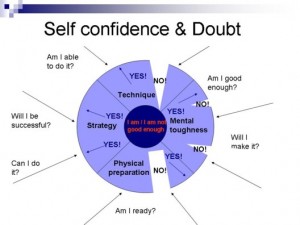According to the treasure trove of info at Wikipedia.com, “self-esteem is a term in psychology to reflect a person’s overall evaluation or appraisal of his or her own worth. Self-esteem encompasses beliefs (for example, “I am competent”, “I am worthy”) and emotions such as triumph, despair, pride and shame. Some would distinguish how ‘the self-concept is what we think about the self; self-esteem, the positive or negative evaluation of the self, is how we feel about it.”
 Self esteem can be simply defined as the way that an individual internally views and values their physical, social, mental and emotional self. You may already know that your self esteem – or lack of – impacts nearly every cognitive decision that you make. But how does it affect your non conscious decisions in the psychological realm? How you view yourself directly impacts how you perceive the world around you, and your relationship to it.
Self esteem can be simply defined as the way that an individual internally views and values their physical, social, mental and emotional self. You may already know that your self esteem – or lack of – impacts nearly every cognitive decision that you make. But how does it affect your non conscious decisions in the psychological realm? How you view yourself directly impacts how you perceive the world around you, and your relationship to it.
Is self esteem important? Yes. There is no other way to look at a term that appears in the diagnostic criteria for the majority of psychological disorders: self esteem is one serious criteria in anxiety, phobia, narcissism, bipolar disorders, etc.
Healthy self esteem balances the internal person to be in harmony with the world. Based on the personality type of the individual, healthy self esteem can manifest in many ways, for each individual personality type has a distinct way of showing itself. Here are some basics to evaluate your own self esteem:
Internally Secure. A healthy individual feels safe within themselves; they are not often beset by feelings of worry or dread. Healthy individuals may be emotive but not overly emotional in a negative sense, for their center is their grounding place. When you look into your own eyes in the mirror, what do you see? Are you comfortable with the synergy between your external actions and your internal person? Are you consciously seeking a healthy balance between life stresses and the internal needs you sense?
Biggest Loser. People with low self esteem are not always the demure, self doubting wall flowers that one might expect. It is often the loudest voice in the room that dominates conversations who drives himself with need for approval. In business meetings, classroom settings and relationships alike, some individuals with low self esteem are “grandiose” to borrow a word from diagnostic criteria, a highly overinflated desire to be considered both knowledgeable and in control. Self esteem projects into the personality that others perceive and react too, both through positive and negative forces.
Magnetic Personality Well grounded self esteem shows in an equally visible manner – people with healthy self esteem are naturally magnetic. They attract attention because of their smile, confidence and willingness to treat people equally. Given that they do not require the approval of others to feed their confidence as the primary source of acceptance, individuals with healthy self esteem are often able and willing to offer a helping hand or listening ear.
It’s all about me. Unhealthy self esteem can manifest as arrogance or complete self focus. Do you read the blog of a friend or associate and immediately assume that person is talking to/about you? Do unknown conversations in your presence make you feel nervous or convicted? Low self esteem can feed or direct fear of change, rejection or even harm. A person that grew up in an unhealthy family environment where appropriate love and affirmation are not provided may find stasis in overcompensating through this channel of feeling. The classic sign of low self esteem are:
- Fear
- Guilt or Unforgiving:
- Depressed Feeling
- Being Too Hard On Oneself
- Unrealistic expectation
- Body image problem:
- Believing that the world is a ‘bad place’
How to Change
So what do you do to feel better about life…and you? You’re ready for the new year and a new you. You’ve made the decision that you want to turn a healthy minute into a healthy life. Where do you begin to change, now that you’ve dared yourself to move out of complacency and into a life of discovery? You can find great worksheets about anxiety, depression and self esteem here.
Step 1: Identify troubling conditions or situations
First, assess yourself. Mentors are great, don’t get me wrong – but mentors and advisers all come with their own set of lenses. Begin by knowing who you are and what your goals are….I have discovered through my process that the only person that knows for sure what and how you feel is you.
- I started with the Enneagram test, found free online at http://www.similarminds.com/test.html . After testing, I took myself to the library and studied what the personality types meant, and how they looked both healthy and unhealthy.
- Following that, I began to research therapies that might be relevant to my own focus. For me, that was beginning with family of origin in my younger years, and more recently, relationships and boundaries.
- After interviewing a few prospective individuals and choosing a personal mentor who would confront me in a loving way, I set measurable goals to assess my own health, and wrote a journal of that metamorphosis daily.
Low self-esteem can negatively affect virtually every facet of your life, including your relationships, your job and your health. But you can take steps to boost your self-esteem, even if you’ve been harboring a poor opinion of yourself since childhood. Start with these four steps that we’ve read and adapted from the Mayo Clinic Site:
Think about the conditions or situations that seem to deflate your self-esteem. Common triggers might include:
A business presentation, crisis at work or home, challenge with a spouse, loved one, co-worker or other close contact, change in life circumstances, such as a job loss or a child leaving home
Step 2: Become aware of thoughts and beliefs
Once you’ve identified troubling conditions or situations, pay attention to your thoughts about them. This includes your self-talk — what you tell yourself — and your interpretation of what the situation means. Your thoughts and beliefs might be positive, negative or neutral. They might be rational, based on reason or facts, or irrational, based on false ideas.
Step 3: Challenge negative or inaccurate thinking
Your initial thoughts might not be the only possible way to view a situation — so test the accuracy of your thoughts. Ask yourself whether your view is consistent with facts and logic or whether other explanations for the situation might be plausible.
Be aware that it’s sometimes tough to recognize inaccuracies in thinking, though. Most people have automatic, long-standing ways of thinking about their lives and themselves. These long-held thoughts and beliefs can feel normal and factual, but many are actually just opinions or perceptions.
Also pay attention to thought patterns that tend to erode self-esteem:
- All-or-nothing thinking. You see things as either all good or all bad. For example, “If I don’t succeed in this task, I’m a total failure.”
- Mental filtering. You see only negatives and dwell on them, distorting your view of a person or situation. For example, “I made a mistake on that report and now everyone will realize I’m not up to this job.”
- Converting positives into negatives. You reject your achievements and other positive experiences by insisting that they don’t count. For example, “I only did well on that test because it was so easy.”
- Jumping to negative conclusions. You reach a negative conclusion when little or no evidence supports it. For example, “My friend hasn’t replied to my email, so I must have done something to make her angry.”
- Mistaking feelings for facts. You confuse feelings or beliefs with facts. For example, “I feel like a failure, so I must be a failure.”
- Self put-downs. You undervalue yourself, put yourself down or use self-deprecating humor. This can result from overreacting to a situation, such as making a mistake. For example, “I don’t deserve anything better.”
Stronger (Kanye West Cover) 30 Seconds to Mars
30 Seconds To Mars – Stronger (Kanye West Cover)Step 4: Adjust your thoughts and beliefs
Now replace negative or inaccurate thoughts with accurate, constructive thoughts. Try these strategies:
Use hopeful statements. Treat yourself with kindness and encouragement. Pessimism can be a self-fulfilling prophecy. For example, if you think your presentation isn’t going to go well, you might indeed stumble through it. Try telling yourself things such as, “Even though it’s tough, I can handle this situation.”
Forgive yourself. Everyone makes mistakes — and mistakes aren’t permanent reflections on you as a person. They’re isolated moments in time. Tell yourself, “I made a mistake, but that doesn’t make me a bad person.”
Avoid ‘should’ and ‘must’ statements. If you find that your thoughts are full of these words, you might be putting unreasonable demands on yourself — or on others. Removing these words from your thoughts can lead to more realistic expectations.
Focus on the positive. Think about the good parts of your life. Remind yourself of things that have gone well recently. Consider the skills you’ve used to cope with challenging situations.
Re-label upsetting thoughts. You don’t need to react negatively to negative thoughts. Instead, think of negative thoughts as signals to try new, healthy patterns. Ask yourself, “What can I think and do to make this less stressful?”
Encourage yourself. Give yourself credit for making positive changes. For example, “My presentation might not have been perfect, but my colleagues asked questions and remained engaged — which means that I accomplished my goal.” (cite, Mayo Clinic 2011)
Here is the caution that I have found to offer you. Well meaning, well intentioned faithful individuals give horrible advice. That pastor, friend and sibling that would never steer you wrong – they will almost inevitably have less than most the facts.

I no longer hurt. Letting go of the past is one way to improve your self confidence, no matter if it was childhood, adolescent or adult memories that block your way to happiness. Forgive..
- Choose what ideas, thoughts and feelings you let in your in as carefully as you choose what you put in your body – garbage in, garbage out.
- avoid believing clichés and “sage” advice.
- Challenge advice that you’re given to see how it actually applies to you and your destiny, contrasting with the individual who is trying to help. Is theirs’ the life that you want? Do they have the destiny that beckons to you?
- Don’t be fooled by a job title or appearance. Interview the person you select to help you. There are just as many pastors and “religious” people in need of counseling as there are in the secular arena. Even psychologists get it wrong at times. Look for solution focused, brief therapy groups that are low cost and high impact. Remember: problems abound in many a perfect seeming life. You are not alone.
Finally, don’t be a selfish person – keeping your whole world tied in knots as you drown in your own emotionality. Don’t be a jerk. If you’re drinking or drugging to dull that ache…get yourself some help. Focusing on yourself and your internal esteem is a journey of discovery and it will be both long and painful if you’re doing the hard work of discovering who you truly are after years of compensating. You may have decades of compound bad choices from health to relationships to deal with and assess. You will not be the same person that you are now – and those changes might also change your outward appearance, relationships, marriage status, profession – you name it. Just as a caution in this time of self discovery if your empathy for people is low, know it and beware.
‘It has been found that people with high self-esteem will be more forgiving than people with low self-esteem.’ (Cite: Wikipedia)
The first step to becoming healthier should not involve stepping on someone else. Allow a few trusted, honest people into that circle of confidence and then prepare for the adventure of a lifetime.

